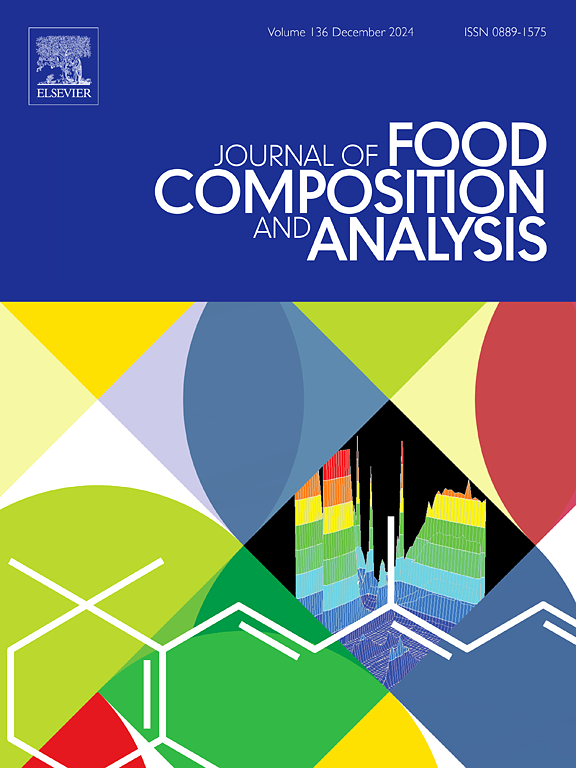开发和验证用于定量检测多种植物源食品中威百亩的气相色谱法
IF 4
2区 农林科学
Q2 CHEMISTRY, APPLIED
引用次数: 0
摘要
为确保食品安全和公众健康,必须建立可靠的方法,对植物源食品中的农药残留进行定性和定量分析。本研究利用 QuEChERS 方法开发并优化了一种气相色谱法,用于检测 22 种植物源食品中的威百亩残留量。通过调整进样温度和转化条件,该方法得到了改进,从而有效地将威百亩转化为其主要代谢物异硫氰酸甲酯。此外,还系统地优化了萃取溶剂类型、体积和纯化剂等参数。该方法的定量限(LOQ)为 0.05 mg/kg,线性范围为 0.025 至 1.0 mg/L,测定系数(R²)为 0.9892 至 0.9999。回收率在 82 % 到 102 % 之间,相对标准偏差 (RSD) 在 0.3 % 到 6.8 % 之间。根据欧盟 SANTE 准则进行的实验室间验证证实了该方法的准确性和可靠性。验证结果通过了 Cochrane 和 Grubbs 测试,重复性 RSD 在 0.70 % 至 5.28 % 之间,再现性 RSD 在 3.62 % 至 21.89 % 之间。该方法为测定威百亩残留量提供了一种可靠而有效的方法,弥补了当前分析技术的一个重要空白,为残留量监测和食品安全法规做出了重大贡献。本文章由计算机程序翻译,如有差异,请以英文原文为准。
Development and validation of a gas chromatography method for quantifying metham sodium in diverse plant origin foods
To ensure food safety and public health, it is essential to establish dependable methods for the qualitative and quantitative analysis of pesticide residues in plant origin foods. This study developed and optimized a gas chromatographic method using the QuEChERS approach for detecting metham sodium residues in 22 plant origin foods. The method was refined by adjusting inlet temperature and transformation conditions to effectively convert metham sodium into its primary metabolite, methyl isothiocyanate. Furthermore, parameters such as the extraction solvent type, volume, and purifying agent were systematically optimized. The method achieved a limit of quantification (LOQ) of 0.05 mg/kg, with a linear range from 0.025 to 1.0 mg/L and determination coefficients (R²) from 0.9892 to 0.9999. Recovery rates ranged from 82 % to 102 %, with relative standard deviations (RSDs) between 0.3 % and 6.8 %. Inter-laboratory validation, in accordance with EU SANTE guidelines, confirmed the method's accuracy and reliability. Validation results passed Cochrane's and Grubbs' tests, with repeatability RSDs between 0.70 % and 5.28 % and reproducibility RSDs from 3.62 % to 21.89 %. This method provides a reliable and effective approach for determining metham sodium residues, and addresses a critical gap in current analytical techniques, offering significant contributions to residue monitoring and food safety regulations.
求助全文
通过发布文献求助,成功后即可免费获取论文全文。
去求助
来源期刊

Journal of Food Composition and Analysis
工程技术-食品科技
CiteScore
6.20
自引率
11.60%
发文量
601
审稿时长
53 days
期刊介绍:
The Journal of Food Composition and Analysis publishes manuscripts on scientific aspects of data on the chemical composition of human foods, with particular emphasis on actual data on composition of foods; analytical methods; studies on the manipulation, storage, distribution and use of food composition data; and studies on the statistics, use and distribution of such data and data systems. The Journal''s basis is nutrient composition, with increasing emphasis on bioactive non-nutrient and anti-nutrient components. Papers must provide sufficient description of the food samples, analytical methods, quality control procedures and statistical treatments of the data to permit the end users of the food composition data to evaluate the appropriateness of such data in their projects.
The Journal does not publish papers on: microbiological compounds; sensory quality; aromatics/volatiles in food and wine; essential oils; organoleptic characteristics of food; physical properties; or clinical papers and pharmacology-related papers.
 求助内容:
求助内容: 应助结果提醒方式:
应助结果提醒方式:


